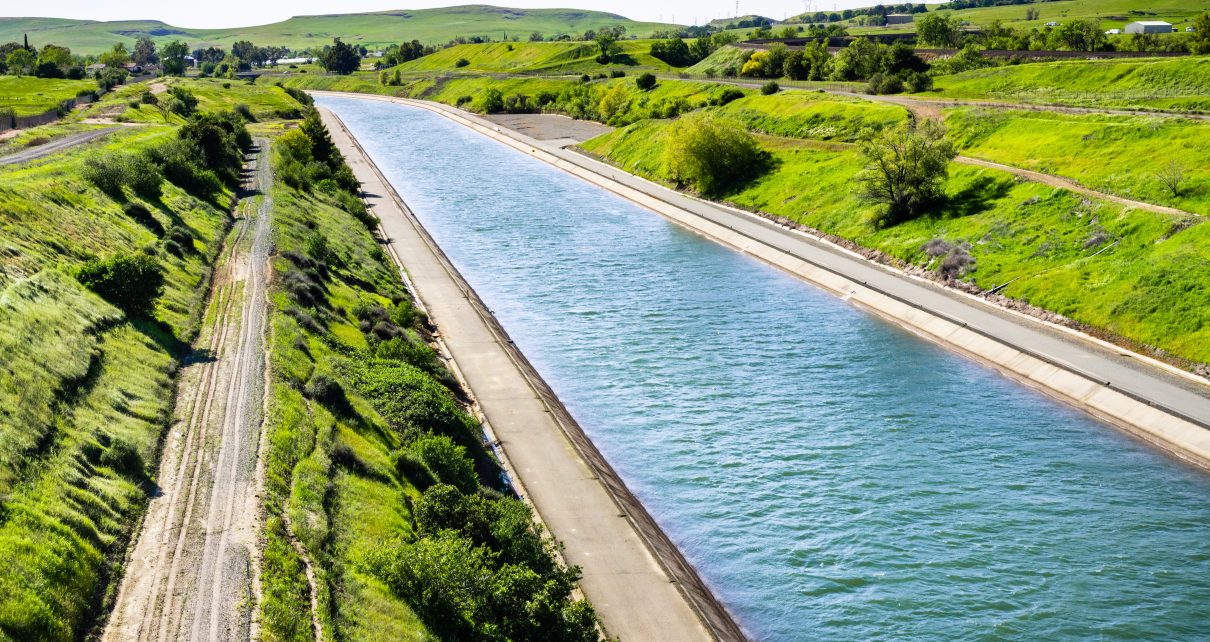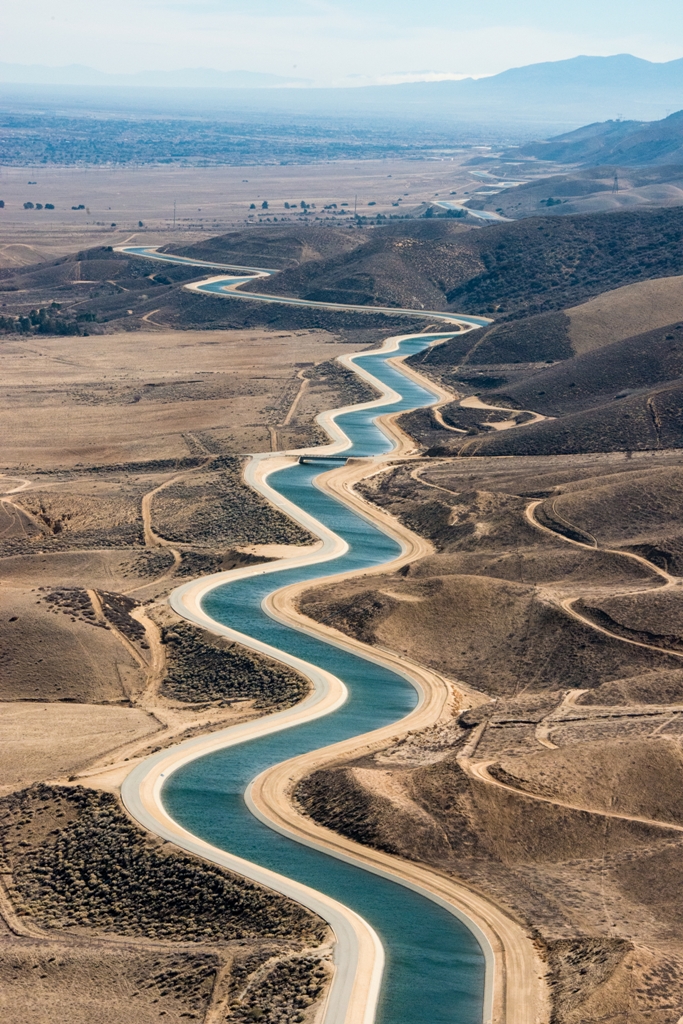
The Thermalito Power Canal in Oroville, Butte County. (Photo: Sundry Photography/Shutterstock)
Environmentally Friendly Delta Diversions Can Increase Water to California’s Cities and Farms
Only about one-third of California’s urban wastewater is recycled
By Edward Ring, December 7, 2022 2:45 am
When it comes to cost-effective ways to increase the supply of water to California’s cities and farms, every idea should be considered. The residential, commercial and industrial water requirements of California’s 40 million people add up to about 8 million acre feet of water per year. The nine million acres of irrigated farmland that produces the food they eat, requires another 30 million acre feet of water per year.
With droughts and increasing priority given to letting water stay in the rivers to maintain ecosystem health, this water supply is threatened. Water scarcity and water rationing, along with fallowing millions of acres of farmland, is the only answer California’s legislature seems to support. Efforts to increase the water supply have been incremental at best.
From a cost perspective, most supply solutions are financially viable, but nonetheless quite expensive. For example, only about one-third of California’s urban wastewater is recycled. Construction costs to upgrade every water treatment plant in the state that isn’t already turning sewage back into recycled water for landscaping or even for potable reuse would cost about $20 billion, and give back up to 2 million acre feet per year.
Desalination is another option, but is roughly twice as expensive as wastewater recycling. For an estimated construction cost of $20 billion, about one million acre feet of ocean water per year could be desalinated. While it is the most expensive option, desalination has the virtue of being a perennial supply of new water, impervious to drought. What other options are there?
In an era that may involve warmer and dryer winters, with less rain and less snowpack, it is necessary to more efficiently harvest runoff from the storms that do hit the state. The traditional way to do this is via reservoir storage, but in-stream reservoirs cannot be allowed to fill from early storm runoff, because that would take away their ability to prevent flooding if there are late spring storms. Then if late sprint storms don’t materialize, there’s inadequate reservoir storage and another water shortage.
Off-stream reservoirs, by contrast, don’t block the flow of a natural river. they are typically constructed in arid valleys, and flood runoff is pumped into them during storm events. Using the proposed Sites Reservoir as an example ($4.0 billion for an annual yield of 500,000 acre feet per year), off-stream reservoirs could capture and release one million acre feet per year for a construction cost of $8 billion. But where will the water come from?
A new proposal, the “Water Blueprint for the San Joaquin Valley,” is a work-in-progress, authored by a coalition of San Joaquin Valley community leaders. The centerpiece of this proposal is to construct what are essentially gigantic French Drains within channels created inside Delta Islands. By drawing fresh water from perforated pipes situated beneath a gravel bed in these channels, flood water could be safely harvested from the Delta during periods of excess storm runoff. Preliminary plans for this system estimate the cost at $500 million per 200-acre facility. The estimated capacity for two of these facilities would be 2 million acre-feet per year or more, at a cost of $1 billion.
The Blueprint also relies on construction of a central canal in the San Joaquin Valley to transport water from the harvesting arrays in the Delta to underground storage. Aquifer storage capacity in the San Joaquin Valley is conservatively estimated at 50 million acre-feet. The projected cost for this canal, including connections to the Friant-Kern, Delta Mendota, and California aqueducts, as well as facilities to recharge and recover water from the aquifers, is $500 million.
This idea has extraordinary potential. Its preliminary construction cost estimate of $1.5 billion to harvest and recover 2.0 million acre feet per year of Delta runoff is a rough order of magnitude lower than any other possible solution.
Moreover, it may well be feasible to safely harvest more than 2.0 million acre feet from the Delta every year. An authoritative 2017 study by the Public Policy Research Institute describes so-called “uncaptured water,” which is the surplus runoff, often causing flooding, that occurs every time an atmospheric river hits the state. Quoting from the study, “benefits provided by uncaptured water are above and beyond those required by environmental regulations for system and ecosystem water” (italics added). The study goes on to claim that uncaptured water flows through California’s Sacramento/San Joaquin Delta “averaged 11.3 million acre-feet [per year] over the 1980–2016 period.”
This is a very encouraging fact. Coming from some of the most respected water experts in California: The average quantity of “uncaptured water” flowing through the Delta that is “above and beyond those required by environmental regulations for system and ecosystem water” averages 11.3 million acre-feet per year.
An environmentally friendly Delta diversion project has several appealing aspects. Unlike the Delta pumps, these extraction channels would not harm fish, nor would they alter the current of the Delta which causes salt water intrusion. Their high capacity may make building the controversial Delta Tunnel unnecessary. Storing high volumes of water in San Joaquin Valley aquifers with a known capacity in excess of Lake Mead and Lake Powell combined would take away the need for more reservoirs at the same time as it would make possible almost a limitless capacity to store water from wet years to use in dry years.
The solutions offered by the San Joaquin Valley Blueprint will benefit farmers, but they will also benefit every coastal urban water agency in the state. Many Southern California water agencies have banked water in Lake Mead, and with that lake at a historic low, they are unable to access that water. Having large scale water banking available just over the hill in the Central Valley is a much safer and practical option. The next step for this project is to build a demonstration facility. And here is where reality already intrudes.
Every water expert consulted for opinions on environmentally friendly Delta diversions had the same answer: It’s a good idea, but it will require 25 years of environmental studies, endless litigation, and there’s a good chance at the end of all that, it still won’t get built.
This is the problem. It has nothing to do with nature and droughts and climate change and wildlife protection. It has to do with a special interest juggernaut whose business model is built on obstructionism and conflict. It doesn’t even have to do with the staggering and unnecessarily inflated cost for any water project undertaken in California, because this state can easily afford any one of the above solutions. Those problems are manageable.
But until California’s politicians, from Gavin Newsom all the way down to an elected board director at the smallest water district in the state, stand up to environmentalist extremists and the scarcity profiteers who pull their strings, there will never again be enough water.
- Ringside: Quantifying California’s Brave EV Future - July 25, 2024
- Ringside: California’s Water Economy – The Three Biggest Choices - July 18, 2024
- Ringside: An Overview of California’s Water Economy - July 13, 2024




HOW do WE change/STOP the litigious battles from every Enviro-Marxist group??
Californians passed bond measures. Politicians *PROMISE TO FIX WATER ISSUES* if elected, knowing full-well absolutely NOTHING can be done because everything ends up in court, even *after* 20-years of “environmental studies”.
The renewable transportation fuels industry (has been) and is currently planning to use crops in the Central Valley to produce oils to make biodiesel and renewable diesel. The current “credit” regulations financially encourage this. These crops use huge amounts of water. This wasteful use could be solved with a stoke of the pen. Growing crops for anything other than for food is unacceptable. Install solar panels on the land save the water.
Can you find evidence of this? You’re right that biofuels are ridiculously land intensive, but I have not been aware of any plan to grow biofuel crops in California. Please post some links to sources for this claim.
The “environment” is simply a weapon leftists wield against the human race that simply want to have jobs and feed their families. I have never seen an evidence that “greens” have any actual interest in improving the environment.
If you really want to understand the whole plan read the CS Lewis book That Hideous Strength. We are about 90% there already!
French Drains (aka infiltration galleries) are susceptible to becoming clogged with sediment.
Self-cleaning conical screens are a much better solution.
See https://isi-screens.com/ for more info.
I am not affiliated with Intake Screens Inc. but I have heard positive comments about their products.
Installing solar over water canals instead of or in addition to ground mount solar prevents some evaporation. Many farmers and ranchers would like a pole barn partnership with PG&E or solar companies, some dairies have acres of roofs. Basically a very high ground mount except on a roof so the space underneath can be used for hay and equipment.